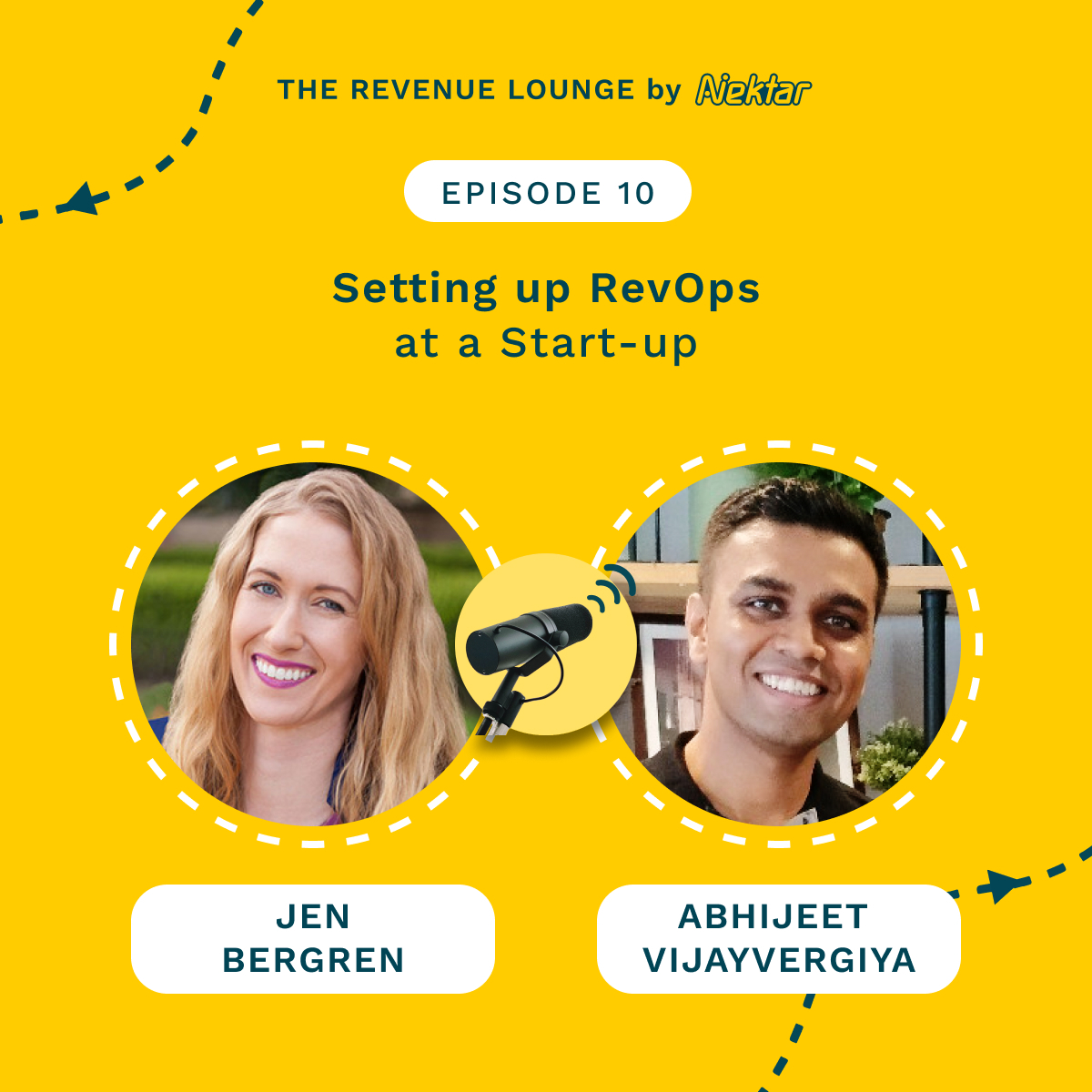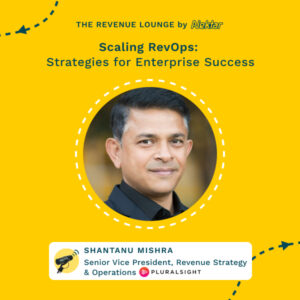Empowering B2B Revenue Teams With Actionable Insights ft. Saima Rashid
February 14, 2024
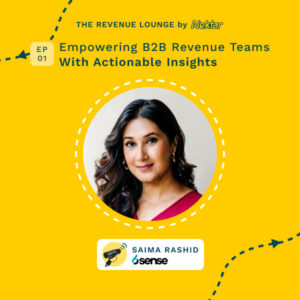
About
The Revenue Lounge
The podcast covers stories from leaders across RevOps, Sales, Customer Success, GTM, Data and Marketing about what drives these functions and what advice they would share with our listeners. With 3 seasons recorded, the podcast currently features 50+ enterprise leaders in the B2B SaaS domain. Tune in to hear from the best in the business
Intro: Saima Rashid, SVP of Marketing and Revenue Analytics at 6 Sense, joins the Revenue Lounge podcast to discuss how organizations can use data and analytics to drive business insights and revenue growth. She provides advice on establishing a single source of truth for data, putting metrics into business context, leveraging AI, and always measuring impact.
Guest Bio: Saima Rashid is the SVP of Marketing and Revenue Analytics at 6 Sense. She is a 5-time industry award winning marketing and rev ops leader with over 17 years of experience building high-impact analytics teams. Saima has driven major change through data-driven approaches to decision making.
Company Bio: 6 Sense is an account engagement platform that helps B2B organizations achieve predictable revenue growth by revealing buyer intent, facilitating account engagement, and measuring account insights. The company combines AI and big data to provide actionable intelligence throughout all stages of the customer journey.
Key Quotes:
“A data and insight, our report means nothing if nobody’s using it.” (00:03:26)
“If you’re doing something, you should have a real clear plan on why, and that includes the success metrics.” (00:10:26)
“If you wait and hope and pray for perfect data to start doing anything, you’ll be waiting for a long time.” (00:11:13)
Main Discussion Points:
– Importance of driving action and adoption from analytics insights
– Strategies for establishing a single source of truth across teams
– Putting data into context to influence behaviors and decision making
– Deriving value from imperfect, incomplete data sets
– Using intent signals and AI to accelerate revenue growth
– Measuring impact and sharing insights broadly to drive change

[00:00:05] Randy Likas: In an era where data reigns supreme, the ability to harness valuable insights can be the key differentiator for organizations striving to maximize their revenue potential. Staying ahead requires more than just traditional strategies. It demands a holistic approach that aligns marketing, sales, and customer success seamlessly, and clean and complete data can help you achieve that and more. Let’s talk about more of this on today’s episode. Hello, everyone.
[00:00:28] Randy Likas: Welcome to the revenue lounge podcast. I am your host, Randy Lykis. And joining me today is Saima Rashid. Saima is the SVP of marketing and revenue analytics at 6 Sense. She is a 5 time industry award winning marketing and rev ops leader with a demonstrated history of driving change and adoption of a data and insights driven approach towards decision making.
[00:00:48] Randy Likas: Hi, Saima. Thanks for joining us today.
[00:00:50] Saima Rashid: Hi, Randy. Excited to be here.
[00:00:52] Randy Likas: Yeah. Me as well. So let’s start just talking a little about your your current role at 6 Sense today.
00:00:57 Making Data Actionable: Insights from Saima Rashid, Head of Marketing and Revenue Analytics at 6 Sense
[00:00:57] Saima Rashid: Yeah. I run marketing at 6 Sense, and I also run revenue analytics, which is an interesting combination when you think of it. Right? But I think it is truly a A marker of the fact that we are so data driven at 6¢. And so I run analytics for marketing sales and customer success, which means that we’re really looking to derive insights to support those internal functions.
[00:01:20] Saima Rashid: So it’s really about understanding what Looks good at what works for all of those functions and then using those insights to really inform how we go to market. And so that’s Particularly exciting for me now that I am in this head of marketing role because we’re just continuing to double down on obviously leveraging 6¢ for 6¢, But just optimizing the way we work, letting the data inform the decision making, taking emotions out of it, which is always a good thing when you talk Business. Right?
[00:01:49] Randy Likas: Absolutely. Yeah. So it sounds like your role is both in in an internal site stand standpoint as well as maybe working with clients, a little bit as well and helping them understand how how they can use data for some of their analytics as well? Is that accurate?
[00:02:01] Saima Rashid: Oh, absolutely. I speak to customers and prospects every day, and I think it’s a real Benefit for me is obviously, you know, running, 6¢ for 6¢. I get great ideas from our customers and prospects, but also, like, Keeping a pulse on what’s going on in the industry, what types of problems folks are looking for solutions to, how 6th Sense can fit into it, I love Geeking out on that sort of stuff.
[00:02:25] Randy Likas: Yeah. It’s so do I. And and we probably use all the time we’ve got to to to geek out. So, well, listen, you know, I had a conversation last week with with a fairly large enterprise and, what they said to me was probably not something that that you don’t hear often, which is we’ve got a lot of data. Right, and and the data exists in a lot of different places and not all the data’s great, like, we’ve got some gaps and not not all of it is completely clean.
[00:02:47] Randy Likas: But what we really need help with is making the data actionable because we’ll build these reports or these dashboards, and they’ll sit in Salesforce, and nobody ever pays any attention to them. Right? So can you talk about sort of the importance of making sure that you’re using the the the data and the analytics derived from that to make it actionable for the business?
[00:03:04] Saima Rashid: Yeah. It’s, it’s a quote I say often to my team and not just at 6th Sense, by the way. I’ve been leading and building analytics teams for 17 years now. My Whole philosophy is a data and insight, our report means nothing if nobody’s using it. We could build the most perfect dashboard That tells the most perfect story for how a business should run.
[00:03:26] Saima Rashid: Who cares if it’s not being used? And so the real important piece, as you mentioned, is taking that data, Deriving insights from it and then taking those insights to action. And oftentimes, the analytics teams Or the folks that are in that data day in and day out, they have to be the the conduits for driving that action, which typically, you know, isn’t necessarily maybe the profile of an analytics person on a team, but the better you can communicate a technical sort of insight to a nontechnical audience, the better you can put the insight into business context so that it is meaningful for the folks that you’re providing that data to, that is what differentiates a good analyst from a great analyst.
00:04:07 The Challenges of Making Data Actionable
[00:04:07] Randy Likas: So so what makes it so hard? Like, what what are some of the challenges, I think, that organizations face when they’re trying to take that data and actually make it actionable? What are some of the sort of, you know, hands on challenges that that companies may face in doing that.
[00:04:20] Saima Rashid: I’ll I’ll start with the very first one, which does everyone agree about what the data is. Right? You ask 3 people in a company to run a pipeline report for you, I guarantee you you will get 3 answers, because there’s so much nuance to how we report on things. As as data has become more accessible, it’s also created, you know, folks, everyone has, like, their hands in it. And I So number 1, I would say sing singular central source of truth, is a big challenge where, you know, if there’s multiple versions of a number, people will always pick Biggest one to to put on their slide.
[00:04:53] Saima Rashid: Right? And so centralization and just standardization of definitions, whether it’s a warehouse, whether it’s Salesforce, whatever your source of truth is, right, just have that be the source of truth. I like to have a centralized analytics team. It doesn’t have to be huge. Right?
[00:05:09] Saima Rashid: But there’s, benefits that come from scale of having a centralized team that is supporting multiple functions. So whether you’re in sales or marketing, the pipeline number is the same. So I’ll start there. And then secondly, I think, Not everyone was hired in their role to be looking at data all the time, and so there’s an interpretation piece of it. Right?
[00:05:31] Saima Rashid: What is a good pipeline number? What is a good deal? How should I interpret this conversion rate? Right? And so putting the numbers into context is critical, and context can be versus a plan number.
[00:05:45] Saima Rashid: So, you know, if are you you’re 10% to plan, you know, you should x is what your number is and your goal is to get to y. That’s a good piece of context. Another piece of context is how are you performing versus the same time last year or last quarter. Right? What you know, is this good for us as a business or not?
00:06:03 Getting alignment on data metrics and context
[00:06:03] Saima Rashid: And so finding ways to put the number into context is also very helpful to then, again, get people to do something about it. If we are converting At a lower rate, if we are generating a lower average selling price for a deal, but you’re selling the same number of deals, it’s still a problem. But the solution that you would apply to each of those situations would differ greatly if you knew what good looks like.
[00:06:26] Randy Likas: Yeah. So it sounds I’m gonna play that back a little bit. So it sounds to me like the first thing you had said was, you know, we need to get alignment across the organization in terms of what are we actually looking at to make sure that when we talk about numbers, we’re talking about the same set of numbers or at least the same understanding of what those are. Then I think when you talk about context, it’s about what’s important to the business, what metrics are we trying to to look at to help move the business. Am I am I capturing that accurately?
[00:06:48] Saima Rashid: Absolutely. And and then the usage of that data just becomes easier. Right? And and, so absolutely context, singular source of truth. I think the 3rd piece, if I had to add something to that, is just the timeliness and relevance of the data.
00:07:03 The Importance of Timely and Relevant Data for KPIs
[00:07:03] Saima Rashid: There’s so many KPIs out there that Who cares? Right? They’re just vanity metrics, so we don’t need to we shouldn’t be spending a whole lot of energy or calories on it, But the timeliness of the good data is important. If it takes us a month to close the books, the business has moved on a month after quarter end. Right?
[00:07:21] Saima Rashid: So if you can get the The data doesn’t necessarily have to be perfect and final down to the decimal point. But if you have a good view of it sooner rather than later, that allows you to make agile And in, you know, in the moment decisions that can, be really costly if you do have that lag.
[00:07:40] Randy Likas: And and how often should should, you look at maybe changing those metrics or changing the data? Right? Because sometimes what we’re measuring what we measure before isn’t necessarily what’s gonna take us where we need to go. Right? How can you talk a bit about, like, how do you introduce sort of the cadence of, like, reevaluating those metrics or adding metrics that maybe weren’t important before or important now?
[00:07:57] Saima Rashid: Yeah. So I think it starts with your plan. Right? And the plan is always going to be against those biggest, most important metrics. Right?
[00:08:04] Saima Rashid: Often those metrics that you’re sharing at the level. Right? Are we gonna hit our revenue targets? Are we generating enough pipeline? Those things stay pretty consistent.
[00:08:12] Saima Rashid: Right? You might add in things like velocity or conversion Or, you know, add in different flavors of it. Before, maybe you were looking at it by business line. Now you’re looking at it by segment and business line And, you know, new business versus upsell. Like, I think there’s flavors of those existing metrics that everyone should be looking at, but You can’t measure everything with the same measuring stick.
[00:08:34] Saima Rashid: And so there are some campaigns, for example, as somebody who who’s the head of marketing, there are campaigns that might never generate Pipeline, but they are very important for us from a brand awareness perspective or from a, health perspective. Right? And so using the right yardstick to measure the right campaign is important, and that’s where I would apply a nuanced approach. You can’t measure everything in the same way, but Whenever you are setting a program live, I think the question of what does success look like and how will we measure it, that’s the time to ask that question so that it’s not 3 months down the road or 6 months down the road that you’re saying, did this work or not? When you are setting something live is when you should be thinking about the success criteria.
00:09:18 How to derive actionable insights from dirty data
[00:09:18] Saima Rashid: And so that’s what we do here. And so it might not be pipeline or revenue for certain things. It might be, you know, increasing ICP web traffic. Are we getting the right accounts to our website so that they’re incorporating us as part of their, research? Well, in that case, Volume of traffic, time on page, engagement.
[00:09:36] Saima Rashid: Right? Bounce rate. Those are very different metrics that we would look at, but Do it when you’re setting that program live, so when you’re putting the thought and the, effort into really developing that overall program.
[00:09:49] Randy Likas: Yeah, I think that’s that’s tremendous advice. Otherwise, you’re just sort of chasing the towel. Right? You don’t really know why you’re measuring it if it doesn’t align back to the plan that you had sort of set out at the very beginning.
[00:09:57] Saima Rashid: Well and, also, why are you doing it Ben, if if you don’t if you’re not measuring it, we’re not just I I wish I had bandwidth and headcount and budget to be trying things just because I felt like it. But If you’re doing something, you should have a real clear plan on why, and that includes the success metrics. And so it’s a great way to even, You know, ops teams are often asked to do hundreds of things. Well, let’s prioritize them and oftentimes putting in these certain gates of, Okay. What’s your measurement plan?
[00:10:26] Saima Rashid: What’s your goal? Those things really help bring the more important and meaningful activities to the top of the list.
[00:10:32] Randy Likas: Yeah. Absolutely. So so one thing that we hear all the time, and I’m sure you do as well, which is, too many companies talking specifically here about, like, CRM data, but it, you know, it it it can apply to many different things. My data is just not very good. Right?
[00:10:45] Randy Likas: It’s it’s dirty. It’s outdated. It’s stale. Reps aren’t good at entering things. Whatever the reason might be, we’re all dealing with data that’s sort of, you know, not complete or not not completely clean.
[00:10:56] Randy Likas: So how do you derive actionable insights for a business when you’re not necessarily working with the cleanest data in the world.
00:11:03 Improving Data Quality for Better Analytics
[00:11:03] Saima Rashid: Yeah. So fun fact, everyone’s data is Pretty bad. Right? Nobody’s got it. I I mean, as much as we’d like to think we’ve got it down, nobody really does.
[00:11:13] Saima Rashid: And so I think just number 1, understanding that that is the reality. And if we wait and hope and pray for perfect data to start doing anything, you’ll be waiting for a long time. So number 1, I would just say understand what you’re working with. And the way to, derive meaning from that is to be consistent in how you’re measuring it and, again, putting the numbers into context versus Last year, last quarter, last month, last week. Right?
[00:11:37] Saima Rashid: So the consistency of measurement allows for controlling some of the factors that you can’t. However, I do think companies should always be working to improve their datasets. And if it’s human things like data entry from a sales rep Or how you’re tagging campaigns and are you capturing certain data points when it’s being set live, those are things that we as ops teams should absolutely be working towards, improving. There’s things you can put in place from just, you know, timing of, and expectations of sellers and marketers, And then there’s tools that you could be using to automate some of that data capture. The more we can take the human equation out of it, the better, of course.
[00:12:18] Saima Rashid: But oftentimes, that’s not possible. So there should be always, you know, work being done to fill in those gaps. Obviously, prioritize which areas you can fix. But the better you can control the quality of the data, the better your analytics will be. Right?
[00:12:34] Saima Rashid: I’ll give you a quick example. If, you know, we’re account based marketing platform, and we sell software that allows companies to understand When prospects are in market for their products and solutions. You know, those predictive models, that AI, that machine learning ties directly into your CRM and marketing automation. And so, of course, the better data you have around opportunity creation, the number of contacts it takes to win a deal, the persona of those contacts, when they engage. Right?
[00:13:01] Saima Rashid: Tools like 6sense can absolutely help make sense of that data. But if there’s a great starting point, you know, that makes it even better for us.
00:13:09 Bridging Data Gaps in Sales and Revenue Operations
[00:13:09] Randy Likas: Yeah, a 100%, one of the the questions I have for you is date data gaps. So, you know, we we we speak we speak with people and they go, I know that there’s gaps in our data right now, but I don’t know how to bring it forward to the business to say that we need to measure this. And I’ll give you an example. Whether it be a complex product or maybe you’re moving upmarket and you’re in enterprise and you’ve got these complex buying committees that are coming together and everybody has sort of different influence, many, many times, the opportunity record doesn’t have a complete buying committee. Right?
[00:13:36] Randy Likas: You just have that one person at the sales
[00:13:38] Saima Rashid: Or any. Yeah. You may be if you require one contact, you’ll get one contact The more I pay.
[00:13:44] Randy Likas: Yeah. Right. Exactly. Ex exactly. So the rev ops person might say, like, I I have a hunch.
[00:13:48] Randy Likas: I know that if we can just get better at knowing who’s involved in our buying community and the influence they have, like, we could have a material impact, but it’s not something that we measure today or get today. What’s your advice for something like that? Like, how how might someone actually take that up in terms of improving some of those gaps.
[00:14:03] Saima Rashid: Yeah. So I think you have to obviously build that business case internally, and and you can do this in a couple of ways. One thing that I’ve done is take a deal. Right? A high profile deal that everyone in the company knows about Nix is excited about.
[00:14:16] Saima Rashid: You if you understand that there’s data gaps, maybe sit with the rep, build out one slide that shows all the touch points along the way, and show that, yes, maybe, you know, The opportunity is showing us 1 or 2 people, but it’s probably a 12, 13, you know, even 20 person cycle. And these were the touch points along the way, and this is What marketing did and this is what sales did. That’s obviously a manual exercise, not scalable, but it can often tell a bigger picture of One deal. One deal a quarter, you know, that’s a great way to get people to start thinking about the benefit of if we had that data, how much earlier we could engage with the right persona. So I think that’s how I I’ve built a business case in the past.
00:14:56 Boosting Customer Retention Rates with Data
[00:14:56] Saima Rashid: And then there’s, you know, things that you can do to augment that. Obviously, there’s tools like Nectar AI that can, you know, automate contact capture from your reps’ inboxes. And there’s tools like 6sense, by the way, that can show you which personas have been most effective on your, past steals, and it will actually highlight and recommend those contacts for you to acquire. So one thing that I do is As an account, starts to show early intent for us, it’s a prospect that we’re interested in. We’re just starting to see some early intent.
[00:15:32] Saima Rashid: I leverage 6¢ to acquire contacts and build out that buying center before that account even is handed off to sales. And then, of course, we ask sales to continue to build out that buying group on the opportunity record. So there’s automation that you can put in place pre opti, You know, if you’re applying an account based motion to build out that, and then there’s technology that you can use post opportunity, right, to augment what the sellers are doing. Either way, I think the better you have a picture of what a great opportunity looks like, the better you can coach your reps and put those processes in place because let’s just do more of what works at the end of the day.
[00:16:09] Randy Likas: Yeah. Absolutely. So let’s pull that thread a little bit farther. Right? So we talk about, like, you know, pre opportunity, but even post opportunity.
[00:16:16] Randy Likas: What about post sale? And let’s talk a little about customer success. And, you know, the like, we we we see it, like, in the industry right now, you know, down sell and churn is just an issue for almost everyone. Right? People are fighting that.
[00:16:28] Randy Likas: People are trying to understand, you know, what that renewal committee looks like because it might not be the same people that have actually purchased the software. What’s some of the data considerations to think about on the on the success side, that, could help boost retention, retention rates?
00:16:41 Using Data to Improve Customer Success
[00:16:41] Saima Rashid: Yeah. So number 1, I think even the handoff from the seller to the CSM, right, the more complete that opportunity was in terms of, both contact data, but also Intent data, keywords data, pain points, content consumed, all of that, the more complete that is, you know, obviously, that’s passed from the sales rep to the CSM when that account is now a customer. But beyond that, right, there’s considerations around adoption. How many folks are are now using the product? How many meetings are you having throughout, you know, that one for the 1st 6 months, let’s say, of a contract?
[00:17:17] Saima Rashid: It’s a great indicator for how the rest of the year is gonna go. And then other data points like, are those customers doing research on your competitors Closer to your renewal date. It’s a great use case, you know, we use at 6¢. A lot of our customers use where our CSMs and our CS leaders will get alerted When an existing customer is is looking at a competitor just so that you can get ahead of it. Right?
[00:17:42] Saima Rashid: And so there’s so many signals out there, and I think the takeaway for anyone listening is really use the data to your benefit. Again, whether it’s a proactive signaling of churn risk, Whether it’s understanding what a great opportunity looks like and those things, even small incremental changes you can make To what, you you know, you’re doing in terms of working your deals can have a huge impact on the back end when it comes to closing more deals, closing them quicker, Hire ASPs because you’re talking to the right accounts and the right people at that account, and you’re really helping that eventual customer account Derive early and good success from your products and offerings.
00:18:22 The Benefits of Data-Driven Decision Making in Revenue Analytics and Marketing
[00:18:22] Randy Likas: Yeah. No. That that that’s excellent advice. What about AI? Like, everybody’s building AI right now.
[00:18:27] Randy Likas: Everybody’s got an AI component of their tools. You know, I’m not talking specifically about AI in our in our respective solutions. But, like, what’s your are you bullish on on AI for the future? Are you thinking it’s being, you know, sort of overblown? Like, we’d love to get your thoughts on on where you think AI is in relation to making sure that we can use data to drive drive business insights.
[00:18:43] Saima Rashid: I work at 6 Sense. I’m bullish on AI. We, you know, we obviously have been in this business for 10 years, whether it was predictive AI or, prescriptive or or descriptive and now generative. Right? And so for me, again, all of the data that is available to us, you really do need Very powerful AI machine learning to make sense of it.
[00:19:05] Saima Rashid: And so, you know, an example is our, generative AI product that we’ve actually had in place for 2 years now. And what this is is it’s an, email assistant, an AI assistant that can take some of the Heavy lifting off of what our BDRs do to do, you know, timely outreach, in context outreach to, prospects that are are showing interest. And we’ve leveraged this, ourselves and are, increasingly generating a higher proportion of our pipeline autonomously through this, and we’ve got some customers that are showing great success. And so hugely bullish on AI, both from our, you know, of course, our product perspective, but also just For marketing organizations, for sales organizations, I think that there’s huge benefit in streamlining what we’re doing, bringing consistency to it, Even just ideating and iterating on things. Right?
[00:20:00] Saima Rashid: It might not it’s it’s not a silver bullet, and it’s not the end all or be all. I don’t think it’s taking our jobs, But I think it is making our jobs a lot more streamlined and efficient and just helping us in in ways that we weren’t able to leverage before.
[00:20:13] Randy Likas: 100%. What’s your favorite part about working in in either, you know, revenue analytics or or or now that you’ve got more of a sort of marketing role, what what’s your favorite part about your job?
[00:20:22] Saima Rashid: I love Basically, what we’re able to do for our customers and prospects. I love speaking to them. I love sharing how we use 6th Sense for 6th Sense with them. We’re almost taking the industry, you know, along with us, and and I I challenge my team to be the best possible customer of 6¢. And so we have to be at that tip of the spear driving net new use cases.
[00:20:44] Saima Rashid: And so it’s cool for me to be essentially running Marketing at a company that sells marketing and sales software because
[00:20:52] Randy Likas: Yeah. You’re you’re you’re on the razor’s edge. Right? And then as a as a 6th Sense user in the past, like, really cool stuff. And so it’s gotta be fun being the marketer for one of the coolest companies out there.
[00:21:01] Saima Rashid: It’s amazing. Very meta, very exciting, and, you know, it’s probably the reason I joined.
[00:21:07] Randy Likas: What about the flip side of that coin? What what’s sort of your least favorite part about it?
00:21:11 Saima Rashid: Challenging Yourself to be the Best in Marketing
[00:21:11] Saima Rashid: Well, you’ve always got a microscope on you. Right? I mean, again, if we’re you’re challenging yourself to be the Best, the one driving, you know, cutting edge use cases. Everyone’s looking for, to you for the next answer, the next quick win. And so it’s an exciting thing, but it’s also obviously, a huge responsibility.
[00:21:30] Saima Rashid: And so, you know, I would say it’s a double edged sword for sure.
[00:21:34] Randy Likas: Yeah. Absolutely. What advice would you give someone who is maybe a little more junior in their career and but they aspire to have your job one day?
[00:21:40] Saima Rashid: It it’s something that I took to heart A long time, and it is about showing impact. At the end of the day, you should always be thinking of the impact that you are driving. Bring meaningful insights to wherever you are, whether it’s a meeting, by the way. You know, this is truly something if you internalize it, you’re gonna do it every day. If you’re in a meeting, you’re there for a reason.
[00:22:01] Saima Rashid: Speak up. Ask the questions. Be present. And then as you’re doing your job, make sure that you are, Going back to measurement, measuring, you know, the impact of what you’re doing and sharing that broadly because those are the sorts of things that will make someone Come to you next time they do need help. And and I’ve started my career in analytics.
[00:22:22] Saima Rashid: And for me to be running marketing at, again, once one of the coolest companies that Out there, I truly think it is because I bring a a different perspective, maybe, but also I’m able to constantly show the impact of the things we’re doing, whether it’s Small little pilot we’re running for 3 weeks or whether it’s a, you know, a big program that we’ve run for multiple years. If you’ve got a pulse On your measurement, if you’ve got a pulse on what’s working and what’s not working, and by the way, how this can improve everyone’s life, make sure you’re using your voice to do that.
00:22:52 Interview with Saima Rashid: Positioning Products and Discussing Challenges
[00:22:52] Randy Likas: Excellent advice. Last question for you. What what’s one book in the recent past that you’ve, or maybe an old standby that you that you love that you might recommend to the audience?
[00:23:02] Saima Rashid: Yeah. I I’m actually gonna give you a fiction and nonfiction because I, I’m reading both. So right now, I’m reading Sales Pitch by April Dunford. It’s in a great book around how to better position your product in today’s competitive lands landscape. So it’s a great read.
[00:23:19] Saima Rashid: I’m not finished yet, but I’ve enjoyed it so far. And then nonfiction, just yesterday, I read a book. I have a son in high school, And so I love to read the books that he’s reading as part of his English class because, you know, we can discuss it, and I love to get his point of view. And so I just finished long way down by Jason Reynolds. It’s a super quick read, but, boy, it leaves you with, you know, A whole lot of thoughts around, just, what life can be like and what sort of challenges folks are facing.
[00:23:52] Saima Rashid: And so I loved it. It it’s starts great conversations, so I’d recommend those too.
[00:23:57] Randy Likas: So one one of my favorite things about hosting the this podcast this season is, I get a collection of really good books to read. So, I will add those 2 to my list and and, look forward to reading them. But, listen, Simon. I appreciate your time. This was a really, insightful conversation.
[00:24:13] Randy Likas: I look forward to, talking with you further, and have a great day.
[00:24:16] Saima Rashid: Thanks so much. I had a blast, Randy.
[00:24:18] Randy Likas: Alright. Thanks.

Ep #1: Navigating the Downturn with a Hyperfocus on Productivity
Listen Now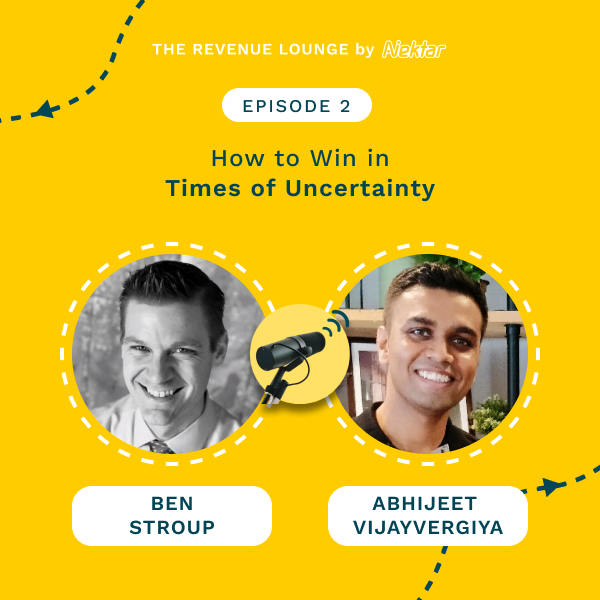
Ep #2: How to Win in Times of Uncertainty
Listen Now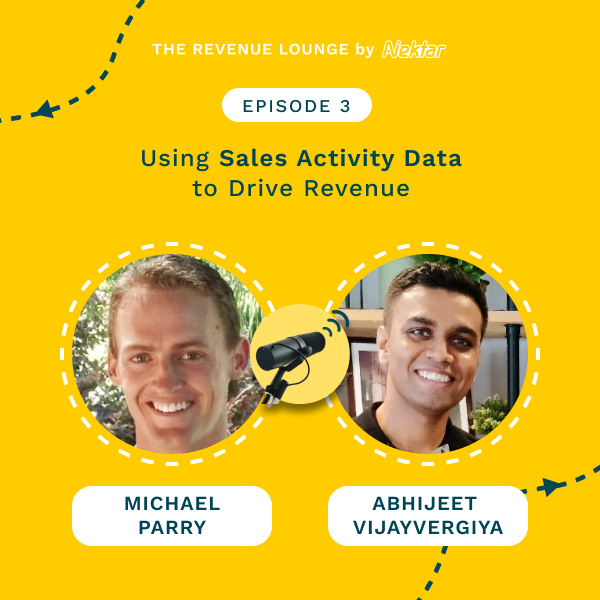
Ep #3: Using Activity Data to Drive Sales Productivity
Listen Now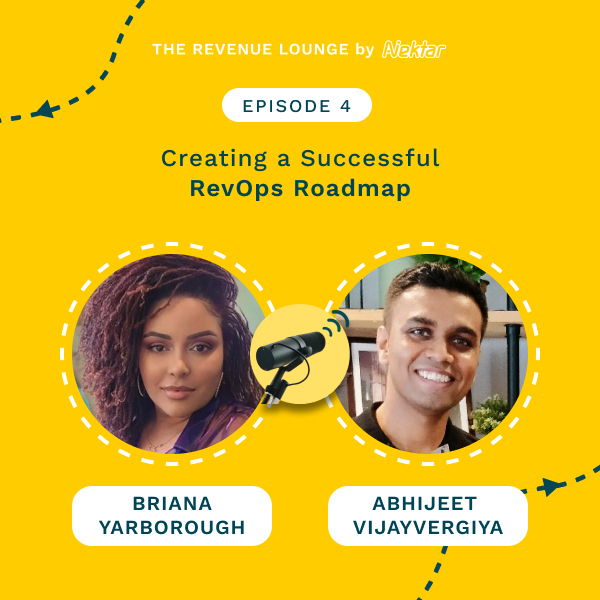
Ep #4: Creating a Successful RevOps Roadmap
Listen Now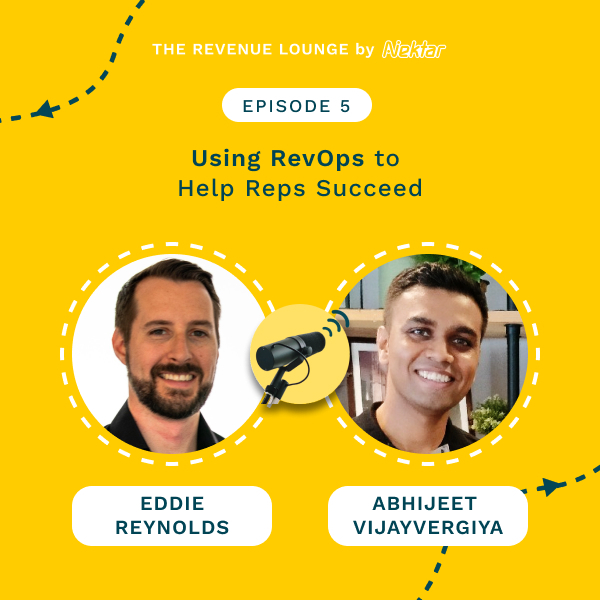
Ep #5: Using RevOps to Help Reps Succeed
Listen Now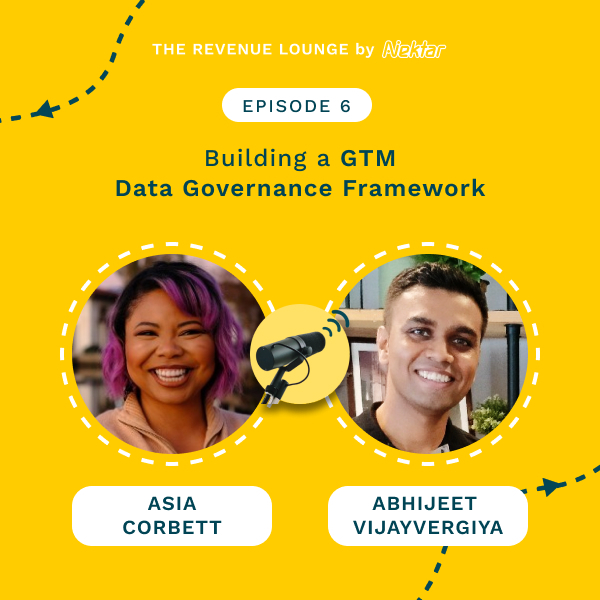
Ep #6: Building a GTM Data Governance Framework
Listen Now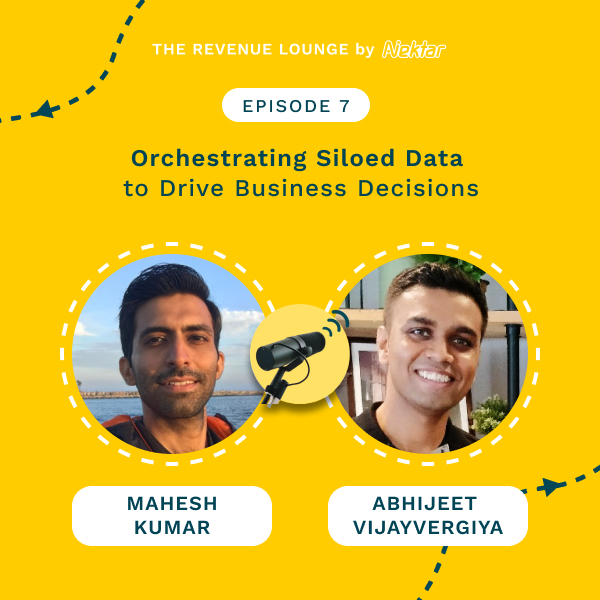
Ep #7: Orchestrating Siloed Data to Drive Business Decisions
Listen Now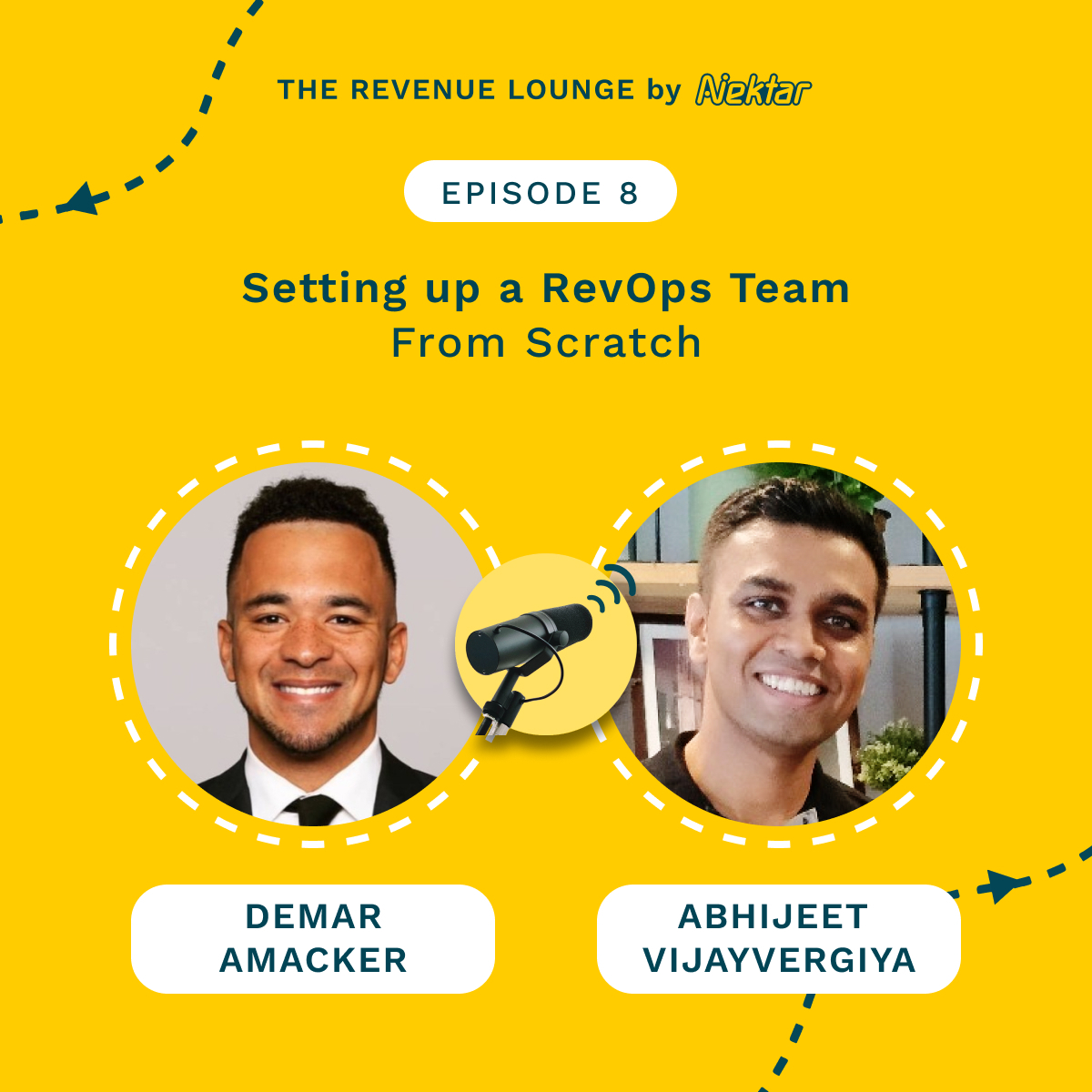
Ep #8: Setting Up a RevOps Team From Scratch
Listen Now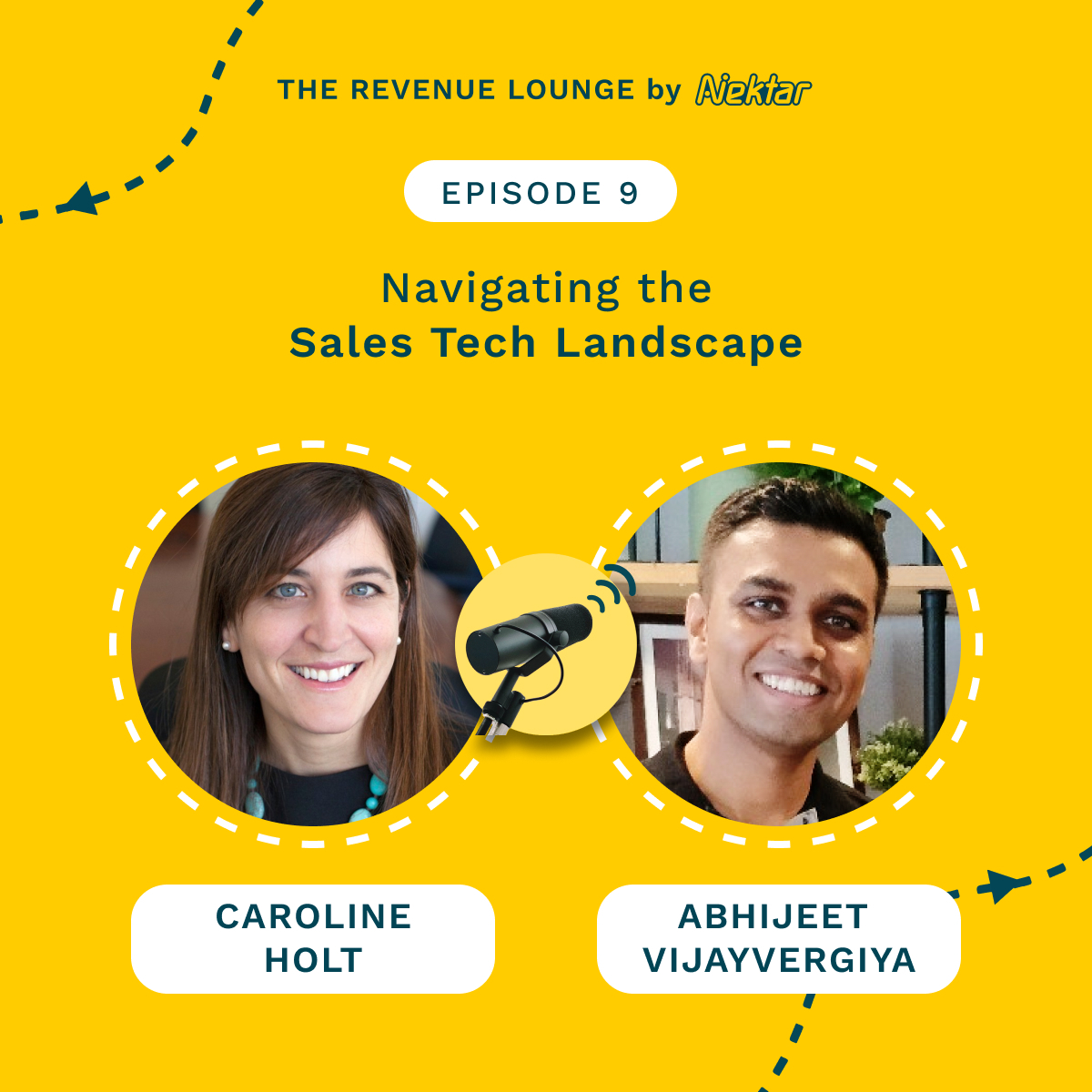
Ep #9: Navigating the Sales Tech Landscape
Listen Now